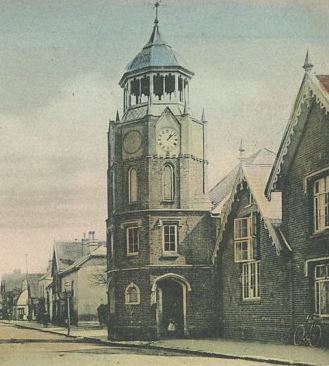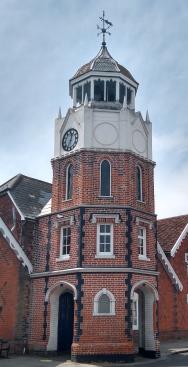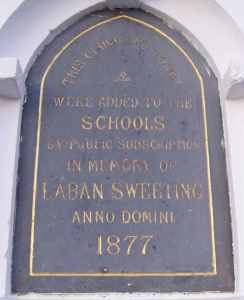Burnham on Crouch Clock Tower
 |
 |
| The Clocktower Then and Now |
The Clock Tower is
Burnham's best known landmark.
It is a red brick
octagonal clock tower with black brick quoins and diapering which
was built in 1877. The tower is in four stages with a fish scale
tiled ogee roof.
The Tower was dedicated to
the memory of
Laban Sweeting a well known local oyster merchant who
was renowned for his philanthropy amongst local residents.

On his death the Clock
Tower was financed partly from public subscription in his memory.
In January 1877 a group of Sweetings friends got together and
declared that the best memorial that a man can leave behind is a
good name which Mr Sweeting certainly did buy his friend proposed
supplementing it with tangible proof of their veneration of his
memory. A committee was formed of Rev J L Govett ( Chairman), Mr G J
A Richardson (Secretary), Mr John Hawkins, Mr G Richardson jnr,
Mr W H Bygrave, Mr John Rogers, Mr W Elphick and W N Sainsbury.
By March 1877 the sum of £282 had been raised and the committee
decided that a Town Clock would be the best memorial.
Various designs were considered but the most favoured design by
local builder, Mr C Read, cost more than the subscription so a sub
committee was formed to raise the additional £50 required. This Sub
Committee consisted of Mr John Prior, G Dilliway, W Ellis, R Hasler,
D Hawkings, J Richmond and Thomas Bell.
The Sub Committee were successful and so the work on the Clock
and Tower that we know as Burnham Clock Tower was approved and a
tender to build it from Mr C Read was accepted.
On Thursday 9 May 1878 the Clock Tower was inaugurated by Rev
Govett with several of the committee members and residents in
attendance.
The tower incorporated a new School Committee meeting room and
office for Church Parochial business on the first floor.
The Clock and bells were manufactured by Gillett and
Blands at Croydon and designed to strike the hour of a bell of 2 cwt
and the quarter hour hours of other bells totaling 4 cwt.
The face of the clock was illuminated at night by gas light
which is automatically turned on and off by apparatus fitted to the
clock.
In the evening a large group of residents met at the Star Inn
for dinner provided by Mr and Mrs Smolt to celebrate the
inauguration.
Guests at the dinner included Rev Govett, Mr G J A Richardson,
Rev H M Milligan ( Creeksea) , Mr G Richardson, Mr J Rogers, Mr A B
Croxon, C Richardson, P Richardson, D Pannell, J Rogers jnr, J
Wackrill, J Smith, C Read, C Lamb, T Bell, W C Staggs, J Cook, J
Eggett and H Flick.

Attached to the clock
tower is St Mary's House which is a building now used as flats
although its former use was as Burnham Endowed School.
The school was founded in
1785 and improved again in 1815 by voluntary subscriptions.
A complete refurbishment
was carried out in 1863 followed by the addition of the Clock Tower
in 1877 despite competition from the new state school opened at
Devonshire Road in 1898.
By 1973 the conditions
were no longer suitable for schooling and the new St Mary's Church
of England Primary school moved to its current site in Marsh Road.




